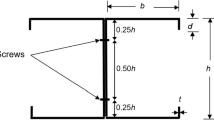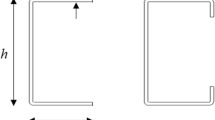Abstract
This paper presents an experimental and finite element (FE) investigation into the local-overall buckling interaction behaviour of axially loaded cold-formed steel (CFS) channel section columns. Current design guidelines from the American Iron and Steel Institute (AISI) and the Australian and New Zealand Standards (AS/NZS) recommend the use of a non-dimensional strength curve for determining the axial capacity of such CFS channel section columns. This study has reviewed the accuracy of the current AISI (2016), AS/NZS (2018) and Eurocode (EN 1993-1-3) design guidelines for determining the axial capacity of CFS channel sections under local-overall buckling interaction failure. A total of 40 tests were conducted on CFS channel sections covering stub, short, intermediate, and slender columns with varying thicknesses. A nonlinear FE model was then developed and validated against the test results. The validated FE model was used to conduct a parametric study comprising 70 FE models to review the accuracy of the current design guidelines in accordance with AISI (2016), AS/NZS (2018) and Eurocode (EN 1993-1-3). It was found that the AISI (2016) and AS/NZS (2018) are conservative by 10 to 15% on average when determining the axial capacity of pin-ended CFS channel section columns undergoing local-overall buckling interaction. Eurocode (EN 1993-1-3) design rules were found to lead to considerably more conservative predictions of column axial load capacity for CFS channels.This paper has therefore proposed modifications to the current design rules of AISI (2016) and AS/NZS (2018). The accuracy of proposed design rules was verified using the FE analysis and test results of CFS channel section columns undergoing local-overall buckling interaction.













Similar content being viewed by others
Abbreviations
- A:
-
Overall web length of section
- Ae :
-
Effective area of the section
- B:
-
Overall flange width of section
- C:
-
Overall lip width of section
- COV:
-
Coefficient of variation
- Cp :
-
Correction factor depending on the number of tests
- E:
-
Young’s modulus of elasticity
- FEA:
-
Finite element analysis
- Fm :
-
Mean of variation of the fabrication factor
- Fn :
-
Critical buckling stress
- Fy :
-
Yield load
- i:
-
Radius of gyration
- Mm :
-
Mean of variation of the material factor
- PEN :
-
Axial strength
- PAISI :
-
Axial capacity obtained from American Iron and Steel Institute
- PEXP :
-
Axial capacity obtained from experiments
- PFEA :
-
Axial capacity obtained from finite element analysis
- Pm :
-
Mean value of the tested to predicted load ratio
- Lcr :
-
Plane buckling length
- Ncr :
-
Elastic critical force
- Vf :
-
Coefficient of variation of the fabrication factor
- Vm :
-
Coefficient of variation of the material factor
- Vp :
-
Coefficient of variation of the tested to predicted load ratio
- Vq :
-
Coefficient of variation of the load effect
- β0 :
-
Target reliability index
- σ0 .2 :
-
Static 0.2% proof stress;
- λ:
-
Imperfection factor
- λc :
-
Non dimensional slenderness ratio
- \({\upchi }\) :
-
Reduction factor for the relevant buckling mode
- \(\phi\) :
-
Capacity reduction factor
References
ABAQUS (2018) Version 6.14-2, USA: SIMULIA, Providence.
AISI manual (2016). American Iron and Steel Institute: North American Specification for the Design of Cold-formed Steel Structural Members (NAS S100).
AS/NZS 4600 (2018). Australia/New Zealand Standard: Cold-Formed Steel Structures, Standards Australia/Standards New Zealand.
BS EN (2001) Tensile Testing of Metallic Materials Method of Test at Ambient Temperature, British Standards Institution.
EC3. Eurocode 3 (2006) design of steel structures: Part 1–3: General rules: supplementary rules for cold-formed members and sheeting. BS EN 1993-1-3. Brussels: European Committee for Standardization.
Ellobody, E., & Young, B. (2005). Behavior of cold-formed steel plain angle columns. Journal of Structural Engineering, 131, 457–466.
Gunalan, S., & Mahendran, M. (2013). Improved design rules for fixed ended cold-formed steel columns subject to flexural-torsional buckling. This-Walled Structure, 73, 1–17.
Hancock, G. J., Kwon, Y. B., & Bernard, E. S. (1994). Strength design curves for thin-walled sections undergoing distortional buckling. Journal of Constructional Steel Research, 31(2–3), 169–186.
Heva, Y. B., & Mahendran, M. (2012). Flexural–torsional buckling tests of cold-formed steel compression members at elevated temperatures. Steel and Comp Structure, 14, 205–227.
Kandasamy, R., Thenmozhi, R., & Jeyagopal, L. S. (2016). Flexural-torsional buckling tests of cold-formed lipped channel beams under restrained boundary conditions. The International Journal of Steel Structures, 16, 765–776.
Loughlan, J., & Yidris, N. (2014). The local-overall flexural interaction of fixed-ended plain channel columns and the influence on the behaviour of local conditions at the constituent plate ends. Thin Walled Structure, 81, 132–137.
Martins, A. D., Camotim, D., Dinis, P. B., & Young, B. (2015). Local-distortional interaction in cold-formed steel columns: mechanics, testing, numerical simulation, and design. Structure, 4, 38–57.
Popovic, D., Hancock, G. J., & Rasmussen, K. J. R. (1999). Axial compression tests of cold-formed angles. Journal of the Structural Engineering. American Society of Civil Engineers, 125, 515–523.
Rasmussen, K. J. R., & Hancock, G. J. (1994). Design of thin-walled plain channel section columns against flexural buckling. Thin-Walled Structure, 20, 219–240.
Rhodes, J. & Harvery, J.M. (1977) Interaction behavior of plain channel columns under concentric or eccentric loading. In: Proceedings of the second international colloquium on the stability of steel structures. Liege, pp. 439–444.
Roy, K., Ting, T. C. H., Lau, H. H., & Lim, J. B. P. (2018). Effect of thickness on the behavior of axially loaded back-to-back cold-formed steel built-up channel sections-Experimental and numerical investigation. Structure, 16, 327–346.
Santos, D. E. S., Batisa, E. M., & Camotim, D. (2012). Experimental investigation concerning lipped channel columns undergoing local-distortional-global buckling mode interaction. Thin-Walled Structure, 54, 19–34.
Shifferaw, Y. & Schafer, B.W. (2011). Behavior and design of cold-formed steel lipped and plain angles. In: Proceedings of the Structural Stability Research Council (SSRC) Annual Stability Conference, Pittsburgh, USA, pp. 10–14.
Silvestre, N., Dinis, P. B., & Camotim, D. P. B. (2012). Developments on the design of cold-formed steel angles. Journal of the Structural Engineering. American Society of Civil Engineers, 139, 680–694.
Wang, C. A., Zhang, Z. N., Zhao, D. Q., & Liu, Q. Q. (2016). Compression tests and numerical analysis of web-stiffened channels with complex edge stiffeners. Journal of Constructional Steel Res., 116, 29–39.
Ye, J., Hajirasouliha, I., & Becque, J. (2018). Experimental investigation of local-flexural interactive buckling of cold-formed steel channel columns. Thin-Walled Structure, 125, 245–258.
Young, B. (2004). Tests and design of fixed-ended cold-formed steel plain angle columns. Journal of the Structural Engineering. American Society of Civil Engineers, 130, 1931–1940.
Young, B. (2005). Experimental investigation of cold-formed steel lipped angle concentrically loaded compression members. Journal of the Structural Engineering. American Society of Civil Engineers, 131, 1390–1396.
Young, B., & Hancock, G. J. (2003). Compression tests of channels with inclined simple edge stiffeners. Journal of Structural Engineering ASCE, 129, 1403–1411.
Young, B. (2006). Local buckling and shift of effective centroid of slender sections. In: Proceedings of the advanced facade engineering and technology symposium, Hong Kong, China, pp. 119–132.
Zhang, Y., Wang, C., & Zhang, Z. (2007). Tests and finite element analysis of pin-ended channel columns with inclined simple edge stiffeners. Journal of Constructional Steel Res., 63, 383–395.
Acknowledgements
The Ph.D. scholarship from Kiwi Steel NZ Ltd is greatly appreciated.
Funding
This research did not receive any specific grants from funding agencies in the public, commercial, or not-for-profit sectors.
Author information
Authors and Affiliations
Corresponding author
Ethics declarations
Conflict of interest
There is no conflict of interest between the authors or any third party regarding the publication of this article.
Additional information
Publisher's Note
Springer Nature remains neutral with regard to jurisdictional claims in published maps and institutional affiliations.
Rights and permissions
About this article
Cite this article
Roy, K., Ting, T.C.H., Lau, H.H. et al. Cold-Formed Steel Lipped Channel Section Columns Undergoing Local-Overall Buckling Interaction. Int J Steel Struct 21, 408–429 (2021). https://doi.org/10.1007/s13296-020-00447-w
Received:
Accepted:
Published:
Issue Date:
DOI: https://doi.org/10.1007/s13296-020-00447-w




